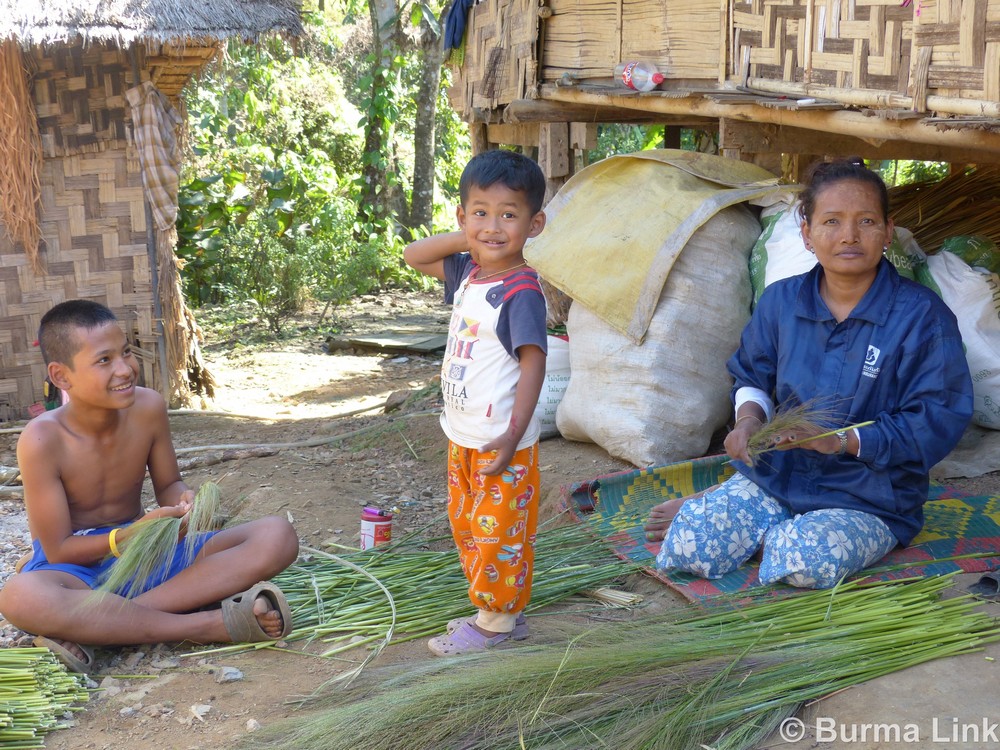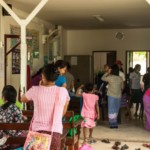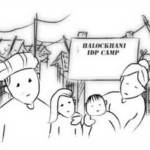This article was originally published on The Irrawaddy on January 20, 2015
Ariana Zarleen, January 20, 2015
SANGKHLABURI, Thailand — Nestled between lush green mountain tops and surrounded by spectacular scenery, Halockhani has been a home for thousands of Mon internally displaced persons (IDPs) for decades.
The village itself currently houses more than 1,000 people, but the surrounding area of five IDP villages is a home to nearly 3,000 people, according to the latest figures from The Border Consortium (TBC), an aid coordination network based on the Thai-Burma border.
As aid diminishes, these hard-working IDPs have little time for anything other than earning a living. Still, their main concern is the collapsing hospital, as every time villagers need a doctor they have little choice but to cross the border into Thailand.
Halockhani is located only one kilometer (0.6 miles) from the border, about 30 kilometers from Sangkhlaburi in Thailand’s Kanchanaburi Province. Right next to the border crossing is the predominantly Karen refugee camp Ban Don Yang.
While it is located in Karen State, Halockhani and the surrounding area is under the control of the New Mon State Party (NMSP) and its military wing, the Mon National Liberation Army (MNLA).
Halockhani remains off limits to foreigners. The area is easiest to access on a four-wheel drive from the Thai side, although the inside route provides sweeping views from the mountain tops, and entails driving on winding and potholed mountain dirt roads with occasional stream crossings.
Diminishing Aid
At first glance, Halockhani closely resembles the Thai border refugee camps. Unlike those on the Thai side, however, many houses in Halockhani are made of permanent building materials such as wood and concrete, forbidden in Thailand where refugees can only use temporary materials.
The village has one generator that provides four hours of electricity every evening to those who can pay for it; approximately 20 percent of the 240 households, villagers estimate.
There is only one place to use a phone, which is a clever set up of plastic bottles and rope on a hilltop that allows the phone to stay both stationary and elevated enough to find and keep a signal.
Sitting on the floor of his house, Nai Chit Toe, the Halockhani village chief explains that they used to get a lot more aid, but since 1997 consistently declined. “We want help,” he says with a sigh.
“In the past, international organizations supported
Other villagers also voiced concerns over lack of rice, among them Mi Sanda Moe. “In the past, we got enough support like rice and other [things]. But now we don’t have enough. It has changed a lot.”
The only other source of rice for the villagers is the nearby refugee camp, where villagers go to buy rice. But rice is expensive and getting it can be risky. “Even when they [Thai police] allow us to enter, when they see rice they take it,”Mi Sanda Moe explained.
With diminishing aid, villagers are forced to survive on their own. “Most people make a living by making floor brooms. It depends on the season,” says the village chief Nai Chit Toe.
Mi Sanda Moe is among the majority who do seasonal work. Although she is a nursery school teacher in the village, she needs to find additional income. “You know staying here we don’t have time to rest, we have to work all the time.”
Twenty-two-year-old Layin Chan, who moved to Halockhani four years ago to be a teacher, shares Mi Sanda Moe’s concerns of a low salary. “For a single person it’s OK, but for the people who are already married and who have children it is very difficult.”
On the other side of the village, rubber is hung to dry outside almost every house. “Even when I’m sick I cannot take a rest. I have to go to farm and work. Sometimes I feel sad. It is really hard to survive,” says Nai Layi Mon, a 50-year-old rubber farmer.
For others still, working is not even an option. Among them are Mi Thin Nyant, 76, and her son Nai Win Halyit, 40. Mi Thin Nyant says she used to do farming and planting rubber, but her son has never been lucky enough to work.
“Since four years old, I got polio. I cannot walk,” Nai Win Halyit said as we sat together on the floor of their house. His mother explained that “he only can sit so we have to pick him up and carry him. I want to buy a wheelchair for him, but I can’t.”
Collapsing Clinic
The villagers now only use the hospital building during emergencies, as villagers are afraid to stay inside. “The wooden bars might fall down on your head,” warns Nai Layi Mon.
Walking across the clinic, the monk showing us the way accidentally stepped through the rotting floor planks, illustrating the urgent need for renovation. Every time villagers need a doctor, they cross the border to Ban Don Yang refugee camp, and sometimes have to travel further inland to the Kwan River Christian Hospital (KRCH).
Mi Thin Nyant, who is too old to work and finds traveling strenuous, has been to the KRCH four times. “I’ve been treated with my own money, and go with my own money.”
“We just need the clinic. We don’t have enough medicine,” says Mi Thin Nyant while urging me to share the information with the outside world.
Nai Layi Mon echoes her concerns: “We have one main difficulty. We don’t have a clinic… The village set up a clinic about twenty years ago, but five years ago the clinic started to break.”
The only international NGO raising funds to rebuild the hospital is the Swedish group Varma Handen. Mirjami Bäckman, the organization’s founder and vice-chairperson, explains that no other international donors are helping to fund the hospital or the village.
For the villagers, hope of a new clinic is already in the air. “The clinic means a lot to us. There’s no place to go. We are hoping the clinic will be rebuilt,” says Nai Layi Mon. “If they rebuild it, we all, the whole village, will be happy.”
The villagers’ hopes might indeed come true with the help of the Swedes who have already raised funds to begin the construction.
Bäckman says that the timetable is entirely dependent on their ability to raise funds. “We will use the money that we have raised so far, but it’s not enough for rebuilding the whole hospital. So we’ll build as much as we can, then raise more funds and build more, and continue like that.”
Changes in Burma
Even with the difficulties, Nai Layi Mon has no intention of moving away from Halockhani. “No one will move to a new place. Just stay here and die here,” he said.
Nai Layi Mon is a former member of the NMSP, and is skeptical about change in Burma. “Just look at the changes in Burma, it is gradually changing. But it is small changes. For ethnic people there is no sign, no changes.”
The NMSP first signed a ceasefire with the government in 1995, which broke down in 2010 as a result of the government’s demand that all ceasefire groups transform into a Border Guard Force. The NMSP refused to meet the demand, and the ceasefire broke. In February 2012, the NMSP signed a new ceasefire agreement.
At the NMSP office in Sangkhlaburi, Nai Boung Khine, head of the NMSP foreign affairs department, is cautiously optimistic.
“We want to establish a federal democratic union in our country. We want Mon rights, self-determination,” Nai Boung Khine explained. “We can change our country. We can change for the people.”
Ariana Zarleen is a co-founder of Burma Link, a Mae Sot-based NGO that works to amplify the voices of Burma’s ethnic nationalities and displaced people.
See the original article on The Irrawaddy.







![‘The Burma Army Killed Him [Saw O Moo] – At Least the Government or the Army Should Commit to Not Do This Again’: Paul Sein Twa, Executive Director of KESAN](https://www.burmalink.org/wp-content/uploads/2018/05/Saw-O-Moo-commemoration-Paul-Sein-Twa-speaking-2-150x150.jpg)